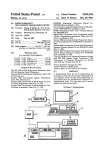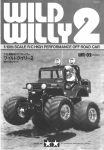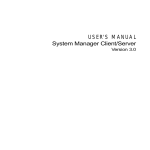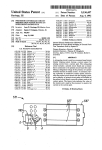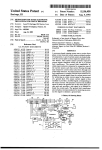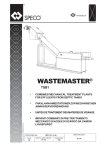Download Circuit interrupter with solid state digital trip unit and positive power
Transcript
‘United States Patentv [191 Elms et al. [54] CIRCUIT INTERRUPTER WITH SOLID STATE DIGITAL TRIP UNIT AND POSITIVE POWER-UP FEATURE [75] Inventors: Robert T. Elms, Monroeville; Gary F. Saletta, Irwin; Bernard J. Mercier, } Appl. NOJ 140,632 ' Int. Cl.3 ............................................. .. H02H 3/ 10 US. Cl. ......................................... .. 361/96 [58] Field of Search ............. .. , 361/44, 92, 9,6, 98; Shimp et al. . ' Monitor. Primary Examiner—Harry E. Moose, Jr. Attorney, Agent, or Firm-Robert E. Converse, Jr. [57] U.S. PATENT DOCUMENTS 4,121,269 10/1978 “Results at Field Experiments of Digital Relays Utiliz ing Minicomputer and Microprocessor”, Suzuki et al., “Operating and Instruction Guide”, Matco Energy 340/8702, 870.72, 870.24; 364/481, 492 References Cited 6/1974 Shimp . 7 England. Power Systems, 6/ 1979. [51] [52] 5/1976 trol”—yHorne et a1; 1975 Conference Developments in Power System Protection 11-13, Mar. 1975, London, “Micro Versatrip Programmer . . . ”, Eckart Industrial Apr. 15, 1980 3,818,275 Mar. 22, 1983 Bulletin, General Electric, 12/1978. ' Filed: 3,956,670 [45] tion of Electrical Power Systems, 2/1977. “Motor Protective Relay IC305 MLTA”, Descriptive [22] [56] 4,377,836 IFAC Conference on Automatic Control and Protec Pittsburgh, all of Pa. [73] Assignee: Westinghouse Electric Corp., Pittsburgh, Pa. [21] [11] . Hobson, Jr. .......... ... ............ .. 361/44 4,232,236 11/1980 Yomogida et a1. ............. .. 361/92 X OTHER PUBLICATIONS “A Microprocessor Oriented Data Acquisition and Control System for Power System Control”-Mulder, 3rd Annual Symposium on Computer Architecture, Clearwater, Fla., 19-21, Jan. 1976. ‘ ABSTRACT . A circuit interrupter includes a microcomputer con~ trolled trip unit having a front panel numeric display and a plurality of LED displays for providing post tripping indication of causeéof-trip and trip current value. Reliable operation is provided during power up conditions. Means are also provided for accurate per formance of long delay and ground fault tripping opera tion. _ “Digital Processors for Substation Switching and Con 14 Claims, 14 Drawing Figures 791 I54, ms? Y u szcmu om nus n2 . ' IIITERLOIX um um um 2 or module nmv: "miss a,’ mam courum 01mm suasvs 11210 2.11210, 1c“ 1m rmmnm Pom fls '92 cum 1 EH ‘Wit FORTI '57 PlO-Pl'! AUTOMATIC’ mum: n IN RESET Pom looI I'UT SllSYSTEI D/A comm U.S. Patent Mar. 22, 1983 Sheet 1 of 13 4,377,836 U.S. Patent Mar. 22, 1983 Sheet 2 of 13’ 4,377,836 a l: av.“ DD MANUAL TRIP colL’zz TRIP’ ,26 UNIT FIG. 2 SOURCE l -/56 SOURCE 2 58 FIG. 3 60) 1 1 1 @5 K Q6 148 6/64 K E: 66 ,1 K El '68 @ El/ EL/IZ 6 ,U.S. Patent N Mar. 22, 1983 4,377,836 7 Sheet 3 of 13 $m28s; \ 3204 CURRENT (IN NULTlPLESl 0F NAX. CONTINUOUS CURRENT) FIG.4 US. Patent Mar. 22, 1983 I54, om aus m SP OTI 4,377,836 Sheet 4 of 13 IIITERLOOII AIIO ARII or v on 0-1 LBACKPLAIIE DRIVE IIICRO ADDRESS OOIIPUTER OUTPUT SUBSYS l/ZIO 2,IOIO, IOII IO I ‘ EXTERNAL PROIA om ‘I53 ‘ PORT:l ALU RAN IIIPUT SUBSYSTEII COMPARATOR I12 I62 REOTIFI FEAR __1‘ UEIEUIUII L PEAK DETECTOR — RECTIFIER gm OROUNO CURRENT FIG. 5 Patent Mar. 22,1983 79 _ __L_ . 80 Sheet 5 of 13 ‘ _ I 105 W? n 4,377,836 U.S. Patent Mar.22, 1983 Sheet60f 13 moFLURTILP0"NWT 4,377,836 . U.S. Patent Mar. 22, 1983 . Sheet 7 of 13 4,377,836 MAI N LOOP ‘2 6N ———————— - F8 Mile rn om on RESE “RESET PUSH aunou ClIAR TRIP rs~ RESET PASE PEAK nmcrmc CAPACITOR “’ DELAY=I6.66T , —S0FTWARETIME "0 COUNTERnOOUNTER-l ~ Fll ' ~ “ "52 mmcmou DISPLAY DISPLAY o 000 ' TRIP VALUE ‘ ins CLEAR RAM , ,rzo DISCRIMINATORY] TRIP ruucnou 7 COUNTER COUNTER-l 1 - m FIG. 7 COUNTmZSSOR 1-4 F25, LOAD MINIMUM ssn'mcs ‘ 'U.S. Patent Mar. 22, 1983 A/ D Sheet 8 of 13 ROUTINE 3mm "r20 0-6» ,% SET cam PREVIOUS POSITION __ m A00. smrr TEST , an mm F29 m SAVE IT IN R2 F3| £21,120 VALUE F32 COMPARE IT WITH ‘F33 ANALOG iNPUT SAVE BT m as #56 F37 IS OOIJNTER- I F38 TRY NEXT BIT POSITION r59, Y RETAINED VALUE m A00. FIG. 8 4,377,836 US. Patent _ Mar. 22, 1983 Sheet 9 of 13 4,377,836 SHORT DELAY ANDINSTATANEOUS TRIP ROUTINE svmcn m7 ‘m ms‘mmsous PEAK nmcnns cmcunmr } 00 All) cowvgnslora F5‘ STORE PPC “F42 rm TALLY- TALLY+| r41 ; IS PPOzITS L r44, mm a STORE VALUE F46 ‘ ' ls TALLYzSD TRIP & STORE VALUE ' T0 LONG DELAY TRIP FUNCTION US. Patent Mar.22, 1983 ‘ LONG DELAY Sheet 10 of 13 RIP ROUTINE SWITCH 10 LD .450 ACCURACY L0 - 32D 00 All) , CONVERSION F5‘ TALLY ' TALLY-MH 4,377,836 U.S. Patent Mar. 22, 1983 Sheet 11 of 13 GROUND FAULT TRIP ROUTINE ' ma LUHG DELAY TRIP FUNCTIUH wan F6!)swncn T eaomw @lm. 1LT PEAK DETECTING GIRGUITRY loo All) CONVERSION asroagi-rs2 SKIP GROUND TEST res, GROUND CURREUTa ACTUAL VALUE - PFC/4 4,377,836 US. Patent Mar. 22, 1983 Sh_eet12 of 13 4,377,836 SELF-CHECK ROUTINE - @m DlSGiARGE mu ,m' omcnuc CAPACITOR m '5 Y "0'0 uocomaslon ‘ ‘ FAILURE II "2) Y FAILURE on us runcnon I ‘ m "hm ‘ n91 s51 rue F80 nnuan N SET M; I F03 F85 ls F84 res, 02 SD? Y N FAILURE "8)0N * sm ruucnon ' I" ,5 a1 N sunis 4 rss \, s51 FLAcvF89 mcnsum sun 45 Y Y “ \ (mumayrso FIG. l2 FAILURE 0N GFP FUNCTION DELAY DISPLAY i ; U.S. Patent .’Mar.’22,198‘3 } Sheet 13 of 13 _ 4,377,836 ‘ ’ READT'ROM ROUTINE H04 , VIRGIN PROM ' OR NO PROM IN SOCKET LOAD MINIMUM SETTINGS - nos I ADDRESS montss, +IOH mm ‘ [i SET ERROR FLAGI I Fl06"( RETURN ) ADDRESS -l0II I READ NET 6 LOCTINS FII2 Fus1 Y I‘ ‘ H LOAD mumuu smmcs LOAD smmcs m CORRESPONDING RAN -/~Fl|4 LOCATION (RETURNYHIS FIG. l3 "1% 1 4,377,836 2 teristics were required such that a circuit breaker would CIRCUIT INTERRUPTER WITH SOLID STATE DIGITAL TRIP UNIT AND POSITIVE POWER-UP FEATURE rapidly open upon very high overload conditions but would delay interruption upon detection of lower over CROSS-REFERENCE TO RELATED circuit breakers were called upon to interrupt upon the APPLICATIONS The present invention is related to material disclosed in the following copending U.S. patent applications, all load currents, the delay time being roughly inversely proportional to the degree of overload. Additionally, detection of ground fault currents. As the complexity of electrical distribution systems increased, the control portions of circuit breakers in a system were intercon of which are assigned to the same assignee of the pres nected to provide selectivity and coordination of inter ruption sequences. This allowed the system designer to specify the order in which the various circuit breakers would interrupt under speci?ed fault conditions. Engel; During the late 1960’s solid-state electronic control Ser. No. 140,631, “Circuit Interrupter With Front 15 circuits were developed for use in high power, low Panel Numeric Display” ?led Apr. 15, 1980 by J. C. voltage circuit breakers. These control circuits per Engel, R. T. Elms, and G. F. Saletta; formed functions such as instantaneous and delayed Ser. No. 140,627, “Circuit Interrupter With Digital tripping which were traditionally achieved by magnetic Trip Unit And Optically-Coupled Data Input/Output and thermal means. The improved accuracy and ?exi 20 System” ?led Apr. 15, 1980 by J. C. Engel, J. A. Wafer, bility of the solid state electronic controls resulted in J. T. Wilson, and R. T. Elms; their wide-spread acceptance, even though the elec Ser. No. 140,554, “Circuit Interrupter With Energy tronic control circuits were often more expensive than Management Functions” ?led Apr. 15, 1980 by J. T. their mechanical counterparts. Wilson, J. A. Wafer, and J. C. Engel; Ser. No. 140,628, “Circuit Interrupter With Digital 25 The earliest electronic control circuit designs utilized discrete components such as transistors, resistors, and Trip Unit And Style Designator Circuit” ?led Apr. 15, capacitors. More recent designs have included inte 1980 by J. J. Matsko, E. W. Lange,‘ J. C. Engel, and B. grated circuits which have provided improved product J. Mercier; performance at reduced cost. Ser. No. 140,504, “Circuit Interrupter With Overtem perature Trip Device” ?led Apr. 15, 1980 by J. J. Mat 30 As the cost of energy continues its rapid rise, there is increasing interest in more effectively controlling the sko, and J. A. Wafer; usage of electrical energy through the design of more Ser. No. 140,553, “Circuit Interrupter With Digital Trip Unit and Means to Enter Trip Settings” ?led Apr. sophisticated electrical distribution systems. Therefore, 15, 1980 by R. T. Elms, J. C. Engel, B. J. Mercier, G. F. there is required a circuit breaker providing a more 35 complex analysis of electrical conditions on the circuit Saletta, and J. T. Wilson; Ser. No. 140,626, “Circuit Interrupter With Digital being protected and even greater capability for coordi Trip Unit And Power Supply” ?led Apr. 15, 1980 by J. nation with other breakers. As always, it is extremely C. Engel, J. A. Wafer, R. T. Elms, and G. F. Saletta; desirable to provide this capability at the same or lower Ser. No. 140,557, “Circuit Interrupter With Multiple cost. Display And Parameter Entry Means” ?led Apr. 15, SUMMARY OF THE INVENTION 1980 by J. J. Matsko, J. A. Wafer, J. C. Engel, and B. J. ent application. Ser. No. 140,559, “Circuit Interrupter With Solid State Digital Trip Unit” ?led Apr. 15, 1980 by J. C. Mercier; Circuit interrupter apparatus is provided for use on Ser. No. 140,556, “Circuit Interrupter With Remote an electrical power distribution system. The apparatus Indicator And Power Supply” ?led Apr. 15, 1980 by J. includes interrupter means for conducting current ?ow C. Engel, J. A. Wafer, B. J. Mercier, and J. J. Matsko; 45 through an associated electrical circuit and for operat Ser. No. 140,625, “Circuit Interrupter With ‘Digital ing to interrupt current ?ow therethrough on com Trip Unit And Automatic Reset” ?led Apr. 15, 1980 by mand, means for sensing flow through the interrupter B. J. Mercier and J. C. Engel; and means, a digital processor, and a front panel display Ser. No. 140,558, “Circuit Interrupter With Digital system. The display system comprises a numeric display Trip Unit And Potentiometers For Parameter Entry” device and a plurality of electrically powered visual ?led Apr. 15, 1980 by J. C. Engel, B. J. Mercier, and R. display indicators. Means are provided to prevent nui sance tripping upon system power-up, to determine BACKGROUND OF THE INVENTION peak current values for each cycle of AC current, and to insure the most conservative settings if unreliable 1. Field of the Invention 55 values of time-current tripping characteristic parame The invention relates to circuit interrupters having ters are entered. Cause of trip and display of trip current means for electronically analyzing the electrical condi is also provided. Accurate determination of long delay tions on the circuit being protected, and means for auto T. Elms. matically opening to interrupt the current flow when , ever electrical conditions exceed predetermined limits. 60 2. Description of the Prior Art Circuit breakers are widely used in industrial and _ commercial applications for protecting electrical con ductors and apparatus connected thereto from damage and ground fault trip operation is also provided. BRIEF DESCRIPTION OF THE DRAWINGS FIG. 1 is a perspective view of a circuit breaker em bodying the principles of the present invention; FIG. 2 is a functional block diagram of the circuit due to excessive current flow. Circuit breakers were 65 breaker shown in FIG. 1; initially designed to interrupt when the current ?owing FIG. 3 is an electrical schematic diagram of a distri through them exceeded a certain level. Gradually, how ever, more elaborate time-current interrupting charac bution system employing the circuit breaker of FIGS. 1 and 2; 3 4,377,836 FIG. 4 is a graph of a typical time-current tripping characteristic, plotted on a log-log scale; FIG. 5 is a block diagram of the trip unit shown in FIGS. 1 and 2; FIGS. 6A and 6B are partial schematic diagrams of 5 the trip unit circuitry of FIG. 5; 4 operator to manually charge a spring (not shown) in the mechanism 20. The manual controls 32 are positioned in the center of the housing 34. Windows 38 and 40 indi cate the state of charge of the spring and the position of the contacts 18, respectively. A push-button 42 allows an operator to cause an internal electric motor to me FIG. 7 is a general ?ow chart of the program stored chanically charge the spring in the same manner as the manual charging operation which can be performed by . FIG. 8 is a flow chart of the analog-to-digital routine the handle 36. A pushbutton 44 allows an operator to stored in the memory of a microcomputer which is a 10 cause the spring to operate the mechanism 20 to close component of the trip unit; the contacts‘ 18. Similarly, a pushbutton 46 allows an FIG. 9 is a ?ow chart of the short delay trip and operator to cause the spring and mechanism 20 to open in the memory of the microcomputer; instantaneous trip functions of the program of FIG. 7; FIG. 10 is a ?ow chart of the long delay trip function the contacts 18. ' The panel of the trip unit 26 is positioned on the left of the program of FIG. 7; 15 side of the housing 34 as can be seen in FIG. 1. This FIG. 11 is a ?ow chart of the ground trip function of panel includes a numeric display device 80 to permit an the program of FIG. 7; operator to observe the value of electrical parameters FIG. 12 is a flow chart of the self-checking routine of on the circuit being protected, a plurality of light-emit~ the program of FIG. 7; and FIG. 13 is a ?ow chart of the routine to read external 20 ting diode (LED) indicators 84, 86, and 88, a rating plug 78 to determine the maximum continuous current of the breaker, and a plug-in programmable read-only mem FIG. 8. programmable read-only-memory of the program of ory (PROM) chip 82 to de?ne the time-current trip characteristic of the breaker. DESCRIPTION OF THE PREFERRED EMBODIMENT 25 General Physical and Electrical Description Reference may now be had to the drawings, in which like reference characters refer to corresponding compo _ nents. A perspective view and a functional block dia USE OF A CIRCUIT BREAKER IN AN ELECTRICAL POWER DISTRIBUTION SYSTEM Before explaining the operation of the trip unit, it will be helpful to describe in greater detail the function of a gram of a moled case circuit breaker l0 employing the 30 circuit breaker in an electrical power distribution cir principles of the present invention are provided in FIGS. 1 and 2, respectively. Although the circuit inter cuit. FIG. 3 shows a typical electrical distribution sys tem. A plurality of electrical loads 48 are supplied rupter 10 is a three-pole circuit breaker for use on a through circuit breakers 50, 52 and 54 from either of three-phase electrical circuit, the invention is, of course, two sources of electrical energy 56 and 58. The sources not so limited and could be used on a single-phase cir 35 56 and 58 could be transformers connected to separate high voltage electrical feeder lines, diesel-powered gen cuit or another type of multiphase circuit. erators, or a combination of the two. Power from the A power source such as a transformer or switchboard first source 56 is supplied through the ?rst main circuit bus is connected to input terminals 12 and an electrical breaker 50 to a plurality of branch circuit breakers 60, load is connected to output terminals 14. Internal con ductors 16 connected to the terminals 12 and 14 are also 40 62, 64, and 66. Similarly, power from the second source 58 may be supplied through the second main circuit connected to interrupting contacts 18 which serve to breaker 52 to a second plurality of branch circuit break selectively open and close an electrical circuit through ers 68, 70, 72, and 74. Alternatively, power from either the circuit breaker. The contacts 18 are operated by a source 56 or 58 may be supplied through the tie circuit mechanism 20 which responds to manually or automati cally-initiated commands to open or close the contacts 45 breaker 54 to the branch circuit breakers on the oppo 18. \ site side. Generally, the main and tie circuit breakers 50, Current transformers 24 surround each of the internal phase conductors 16 to sense the level of current flow through the conductors 16. The output from the current simultaneously supplied by both sources. The capacity the level of ground fault current flowing in the circuit. The trip unit 26 constantly monitors the level of phase and ground fault currents ?owing in the circuit to occur at, for example, the point 76, it is desirable that this condition be detected by the branch circuit breaker 52 and 54 are coordinated so that no branch circuit is of the main and tie circuit breakers 50, 52 and 54 is transformers 24 is supplied to a trip unit 26, along with 50 usually greater than that of any branch circuit breaker. the output from a current transformer 28 which senses If a fault (abnormally large current ?ow) should 62 and that this breaker rapidly trip, or open, to isolate which the breaker 10 is connected and initiates a com 55 the fault from any source of electrical power. The fault mand signal to a trip coil 22 which actuates the mecha at the point 76 may be a large over-current condition nism 20 to open the contacts 18 whenever electrical caused, for example, by a short circuit between two of conditions on the circuit being protected exceed prede termined limits stored in the trip unit 26. During normal the phase conductors of the circuit, or an overload only slightly above the rating of the breaker such as might be conditions, the mechanism 20 can be commanded to caused by an overloaded motor. Alternatively, it may open and close the contacts 18 through manually be a ground fault caused by a breakdown of insulation initiated commands applied through the manual con on one of the conductors, allowing a relatively small trols 32. amount of current flow to an object at ground potential. Referring to FIG. 1, it can be seen that the circuit In any case, the fault would also be detected by the breaker 10 includes a molded insulating housing 34. The 65 main or tie breakers 50, 52 or 54 through which the load terminals 12 and 14 are on the rear of the housing 34 and fed by branch breaker 62 is supplied at the time of the are thus not shown in FIG. 1. A handle 36 is mounted fault. However, it is desirable that only the branch cir on the right-hand side of the housing 34 to allow an cuit breaker 62 operate to isolate the fault from the 5 4,377,836 source of electrical power; The reason for this is that if - the main or tie circuitvbreakerv should trip, electrical power would be lost to a greater portion of the entire system than merely the load attached to the branch circuit on which the fault occurred. It is therefore desir able that the main' and tie circuit breakers 50, 52 and 54 should have a longer delay period following detection of a fault before they initiate a tripping operation. The coordination of delay times among the main, tie, and branch circuit breakers for various types of faults and the need for interlocking between breakers are major reasons for the need to provide sophisticated control in a trip unit. TIME-CURRENT TRIPPING CHARACTERISTICS In order to achieve the coordination between circuit breakers as described above, the time vs. current trip ping characteristics of each circuit breaker must be 6 TRIP UNIT FUNCTIONS AND MODES The functions and modes of the trip unit 26 employ ing the principles of the present invention will now be described. A rating plug 78 is inserted into the front panel of the trip unit 26 to specify the maximum contin uous current to be allowed in the circuit being protected by the circuit breaker. This may be less than the actual capacity of the circuit breaker, which is known as the frame size. For example, the frame size for the circuit breaker may be 1,600 amperes; however, when the breaker is initially installed the conductors of the circuit being protected may be sized so as to continuously supply only 1,200 amperes of electrical current. There fore, a rating plug can be inserted in the trip unit to ensure that the maximum continuous current allowed by the circuit breaker will be only 1,200 amperes even though the circuit breaker itself is capable of safely carrying 1,600 amperes continuously. speci?ed. Circuit breakers have traditionally exhibited Throughout the remainder of the description of the characteristics similar to that shown in FIG. 4, where invention, current levels may be described as multiples both axes are plotted on a logarithmic scale. When of the maximum continuous current as speci?ed by the rating plug. This convention will be expressed as, for current below the maximum continuous current rating of the breaker is ?owing, the breaker will, of course, remain closed. As current increases, however, it is de sirable that at some point, for example the point 300 of FIG. 4, the breaker should trip if this overload current persists for an extended period of time. Should a current ?ow equal to the maximum continuous current rating as speci?ed by‘point 300 persist, it can be seen from FIG. 4 that the breaker will trip in approximately 60 seconds. At slightly higher values of current, the time required for the breaker to trip will be shorter. For example at . 1.6 times maximum continuous current as speci?ed by example, 3 per unit or 3 p.u. to indicate a current level of three times the maximum continuous current. As can be seen in FIG. 1, the trip unit panel contains a numeric display indicator 80 and a number of LED indicators 84, 86, and 88. The electronic circuitry inter nal to the trip unit causes the numeric display indicator 80 to sequentially display the present value of electrical conditions on the circuit being protected and the vari ous limit settings de?ning the time-current trip curve of the breaker as currently set. The LED’s 84, 86 and 88 indicate whether a ground fault, long delay overcur point 302, the breaker will trip in about 20 seconds. The portion of the curve between the points 300 and 304 is known as the long delay, or thermal, characteristic of the breaker, since this characteristic was provided by a To the right and below the numeric display indicator 80 and rating plug 78 is a plug-in programmable read bimetal element in traditional breakers. It is desirable that both the current level at which the long delay only memory (PROM) module 82, such as a type 3601 manufactured by the Intel Corporation, in which are portion begins and the trip time required for any point stored the various limit values and settings which spec ify the time-current tripping characteristics of this par ticular circuit breaker. The method of loading the set tings into ‘this module and the manner in which the module is used by the trip unit circuitry will be de on that portion be adjustable. These parameters are known as long delay pick-up and long delay time, re spectively, the variation of which is indicated by the arrows 306 and 308. At very high overcurrent levels, for example 12 times the maximum continuous current and above, it is desir able that the circuit breaker trip as rapidly as possible. This point 312 on the curve is known as the “instanta rent, or “instantaneous” overcurrent was the cause of a trip operation. scribed in a later section. SYSTEM DESCRIPTION The trip unit circuitry includes a digital arithmetic neous” or magnetic, trip level, since traditional breakers logic and control processor 154 such as the type 8048 employed an electromagnet in series with the contacts to provide the 'most rapid response. The instantaneous microcomputer manufactured by the Intel Corporation, pick-up level is usually adjustable, as indicated by the and is presented by block diagram in FIG. 5. This sec tion will describe each block of FIG. 5 and present a arrow 314. description of the operation of the trip unit. To aid in coordinating breakers within a distribution system, modern circuit breakers have added a short The microcomputer 154 contains an arithmetic logic unit (ALU) 153, 64><8~bit bytes of read-write random access memory (RAM) 155, 1KX8-bit bytes of read only memory (ROM) 157, an 8-line data bus 172, and ‘delay trip characteristic 316 between the long delay and instantaneous portions. The present invention allows adjustment of both the short delay pick-up level and the short delay trip time as indicated by the arrows 318 and v 320. _ two 8-line input-output ports Port 1 and Port 2. Other types of digital arithmetic logic and control processors could be used, such as those requiring outboard mem Under certain conditions it is desirable that the trip ory circuits rather than having the on-chip RAM and time over the short delay portion vary inversely with 65 ROM circuits of the 8048. However, for a detailed the square of the current. This is known as an I2t char description of the microcomputer, reference should be acteristic and is indicated in FIG. 4 by the broken line made to the MCS-48 Microcomputer User’s Manual 310. published by the Intel Corporation. 7 4,377,836 8 crocomputer 154. The technique is shown in greater detail in the ?ow chart of FIG. 8. The function of transistors 102 and 104 and their CIRCUIT DESCRIPTION Referring to‘ the system block diagram of FIG. 5 and the detailed schematic diagrams of FIGS. 6A and 6B, the display section 79 is ?rst described. It consists of four data latches IC5, 1C6, 1C7 and 1C8 and the four associated components is to direct the phase (or ground) currents from the CTS 24 and 28 to the rating plug resistor 105 during non-tripping operation. However, digit liquid crystal numeric display 80. The data latches when a trip condition is sensed and the trip SCR 98 is may be the type MC 14543. Display data is multiplexed on the data bus 172 of the microcomputer; the four least signi?cant bits represent data and the four most signi? cant bits its position on the display. The liquid crystal display 80 derives its back plane clock from the interval turned on, transistors 102 and 104 are turned off, thereby directing essentially all of the phase (or ground) current signal into the shunt trip coil for a positive tripping action. Power for the trip unit circuitry is supplied by re timer 92. This interval timer also ful?lls the function of chargeable battery with charging power produced by resetting the microcomputer if it does not receive its clock signals from the microcomputer 154. Under nor mal operation, the microprocessor outputs a pulse on every execution of the main program loop. the current transformers 24. Alternately, power could be derived directly from the current transformers 24 or independently via connections to the conductors 16. outputs its contents via Port 1. Since the display section DESCRIPTION OF OPERATION The operation of the invention is described in detail in this section. In the ?rst part, a general ?ow chart of the 79 and the address lines of the PROM 82 are both con program and the allocation of memory are presented. nected to the data bus 172, the address information for the PROM would tend to cause a garbled display. How ever, the address information appears on the bus for only a small fraction of a second, to be immediately be described in the second part. It can be seen on the diagram of FIG. 5, that the PROM 82 receives its address from the data bus 172 and Major subroutines called from the main loop will then DATA MEMORY ALLOCATION The allocation of the internal RAM 155 of the mi crocomputer 154 is shown in Table I. TABLE I followed by valid display information. The LCD dis play therefore does not have time to respond to the PROM address information and the operator observes only the valid display information. The output subsystem 94 consists of % of a type A775 comparator 1C2, and of quad NOR gate IC10 and quad NAND gate IC11. Through comparator 1C2 the mi 30 DATA MEMORY MAP (RAM) 63 62 61 Long Delay Pick-up (LDP) Long Delay Time (LDT) Short Delay Pick-up (SDP) signal after a ground fault pickup. Through the NAND 35 60 Short Time (SDT) gate of IC11 the microcomputer sets the corresponding 59 58 Instantaneous Trip Setting (ITS) Ground Fault Pick-up (OFF) LED indicator 84, 86 or 88 after a trip. 57 Ground Fault Time (GFT) crocomputer 154 via Port 2 sets an interlock output The NOR gates IC10 provide the high-level output signal to trip a single SCR 98 under ground, short delay, long delay, or instantaneous trip. It also forces this trip signal to follow the RESET signal during power-up thus eliminating false tripping during the 10 ms period of microcomputer instability after power is ?rst applied. The input subsystem 100 consists of two peak detect ing circuits including capacitors 90 and 91, a type ZN425J D/A converter 1C4, the other half of compara tor 1C2, and the analog switches of 1C3. The capacitors 90 and 91 store the peak value of phase and ground current, respectively, for each cycle of the AC line. The peak values are then read every cycle by the microcom puter. The capacitors 90 and 91 are reset (discharged) later in each cycle by the microcomputer through a ,transistor 96 and IC11 activated by Port 2. The analog-to-digital conversion of the signal from the input subsystem 100 is accomplished by an iteration technique employing the D/A converter 1C4 and com parator 1C2. A digital value is supplied to the D/A converter 101 by the microcomputer 154. This value is converted to an analog value and supplied to 1C2. 1C2 then compares this value to the value supplied from capacitors 90 or 91 through the analog switch 1C3 and indicates whether or not the value supplied by IC4 is larger. The result of this comparison is supplied via the T1 test input to the microcomputer 154, which then 40 45 56 55 54 53 52 51 Sum Sum Sum Sum 6 = Tally of GFT 4 = Tally of SDT 45 = Self-checking Sum 4 65 = Self-checking Sum 45 5O 49 48 47 46 45 Sum 3 = Lower Tally of LDT Sum 2 = Middle Tally of LDT 44 43 42 Sum l = Upper Tally of LDT 41 Trip Flag 40 Cycle Counter 39 38 37 Present value of inst. current Present value of GND current 36 Trip value 35 55 34 33 32 Display index Low byte of addr. of next display High byte of addr. of next display As can be seen, the top eight locations are used to load the limit value settings, such as Long Delay Pick— Up and Long Delay Time. The values in these locations are refreshed every 4 seconds, after a reading of the external PROM 82. The tallies for ground fault, short delay, and long delay timing functions are also kept in generates a new value to 1C4. This process continues 65 RAM. The address of the next information to be dis until the value generated by the microcomputer 154 is very close to that supplied by the analog switch 1C3, and the result is retained in the accumulator of mi played, the present value of ground and instantaneous current, and the trip value are stored in locations shown. The addressing of those values is done indi 9 4,377,836 rectly through Register (0 (R0) or Register 1 (R1) which contains the particular address. The lower 32 words of data memory are used for standard “housekeeping” functions of the microcom puter, as explained in the previously referenced Intel unit format, the parameter being displayed is identi?ed by a numeric code which appears ‘concurrently with the parameter value in the left-most digit of the numeric display 80, as follows: 1. Present Phase Current User’s Manual. MAIN LOOP Refer to the flow chart of the main loop shown in FIG. 7. After the system is powered-up or the reset button on the front panel is pushed, the program counter of the microcomputer 154 is loaded automati cally with 00¢ hex. An instruction at this location brings the microcomputer to three initialization rou tines: clear RAM, load display with M010, and perform discriminatary trip function. In the latter function, the 10 tion is done immediately after reading the PROM 82 and 255 X16667 ms (4.27 sec) thereafter. The parameter display is a three-digit number in per 2. Long Delay Pick Up . Long Delay Time . Short Delay Pick Upv . Short Delay Time . Ground Fault Pick Up . Ground Fault Time 15 . Instantaneous Trip Level . Present Ground Current present value of the phase current is compared with 9.0 When the counter reaches 125 (2.1 sec) and if an error p.u., i.e. nine times rated current. Thus, if the breaker is was found in the self-checking routine, an error code experiencing a high overload when the trip unit is ?rst will be displayed in the indicator 80 instead of a parame powered-up, the program is able to trip the breaker 20 ter value: 1 for A/D conversion failure or instantaneous within 0.5 ms. These initialization routines are executed trip function failure, 2 for short delay function failure, 3 only during power-up or reset. for. ground trip function failure, and 4 to indicate that At this point the program counter is decremented to minimum settings are being used.'This will cause the FF hex or 255 decimal. This count signals the mi crocomputer 154 to read the external PROM 82. If the 25 indicator 80 to change from parameter value to error code every two seconds, indicating to the user that an PROM 82 is unreadable (contents= MH or FFH) or the error was found. checksum is invalid, minimum limit value settings (from ROM 157 internal to the microcomputer) are loaded in DETAILED DESCRIPTION OF OPERATION This section will describe, in detail, the function corresponding RAM locations. Otherwise, the last six teen memory locations of the PROM 82 are read. The 30 blocks shown in the general flow diagram. Reference use of a 2K PROM will thus allow the user to repro should be made to the ?ow diagrams presented for each gram a new set of limit values into the PROM 16 times, block. before a new PROM must be employed. (16x16 va GIN. From then on, this will be the starting point of the Considering the instantaneous trip function and short delay trip function ?rst, refer to the flow chart of FIG. 9. Upon entering those two routines, the microcom main loop. puter 154 switches the D/A converter IC4 analog out The internal ROM 157 of the microcomputer 154 includes a look-up table containing the addresses of the tors 108, 110 and 112, having values of 6.8K, 220K, and lues><8 bits per value=2048). After reading values from PROM, the program jumps to entry location BE 35 put to the phase peak detecting circuitry through resis subroutines which prepare the formats to enable the 40 220K, respectively. This produces a scale factor of l p.u. (with a digital representation of 160). The A/D various parameter values to be displayed. Through an conversion (FIG. 8) subroutine is now called which index R34 (initialized at 0) and updated by each display ‘lasts 0.26 ms (104 instructionsX2.5 ucs average execu routine) the address of the next display routine is read tion time). and stored in R33 and R32 of RAM 155. The A/D conversion subroutine operates by clearing Next, the four main functions of the program are 45 the accumulator, then setting the most signi?cant bit entered: the instantaneous trip function, the short delay trip function, the long delay trip function and the ground trip function. Those functions will be presented in detail in the next section. A self-checking subroutine is next executed. In this 50 subroutine, the analog-to-digital converter, short delay pick-up, and ground test functions are checked. If a failure is detected, a failure flag is set and an error code stored in RAM 155. thereof as a test value. This value is sent to the D/A converter which produces a corresponding analog value. This analog value is compared to the phase cur rent value provided by the peak detecting capacitor 90. If the trial analog value is smaller than the phase cur rent, then the trial value consisting of one bit is added to the digital successive approximation of the phase cur rent value which is retained in register R3. The test bit The capacitors 90 and 91 for storing peak phase and 55 in the accumulator is then shifted one place to the right, a corresponding analog test value generated, a compari ground current are then discharged and a time delay son made, and the bit is retained or not in register R3 executed equal to 16.667 ms less the time expended in executing the main loop instructions. according to the results of the comparison. In a similar A ?ag is next checked to determine if a tripping oper manner all eight bits of the accumulator are tested and ation has occurred. If so, the value of phase or ground at the completion of the eighth bit, the retained value in current which caused the trip is now displayed. Since R3 is transferred to the accumulator. the trip unit is powered externally, a tripping operation ’ will not inhibit execution of the microcomputer soft ware. The digital value of present phase current (PPC) is then stored in RAM 155 in order to be displayed and used in the Short Delay routine. If PPC is greater than After the ?rst cycle, the main counter is ‘at 254D. This 65 the instantaneous trip setting (ITS), a tripping operation number signals the microcomputer 154 to select another parameter to be displayed by the indicator 80. Realizing that this count is circular, it can be seen that the selec is executed, which includes the function of saving the current value which caused the trip (to be displayed on indicator 80) and lighting the proper LED 84, 86 or 88 4,377,836 . 12 11 to indicate cause-of-trip. Otherwise, the short delay trip frame rating, the ground fault pick-up is desensitized so function is entered. that the fictitious ground fault current (an artifact of the ' current transformers) will not cause an improper trip, In the present trip unit as can be seen in the ?ow chart of ‘ In the Short Delay routine, a tally is incremented' every cycle if the PPC is larger than the short delay pickup. The tally is then compared to a value corre FIG. 11, further corrective action is provided. The ground fault pick-up is desensitized, as in the prior art, when PPC is greater than or equal to 7.0 PU; however, sponding to the short delay time setting (SDT). If the tally is greater than the SDT value, a trip operation is called for. Otherwise, the Long Delay Test routine is for PPC between 1.0 and 7.0 PU, the ?ctitious ground ' entered. If the PPC is smaller than’ the short delay pickup the short delay tally is reset to zero. At this point O current is accounted for by subtracting from the ground current sensed, the PPC divided by 4. This method the Long Delay Test (LDTST), as shown in FIG. 10, is could, of course, be accomplished by other means, such entered. Upon entry, the LDTST function switches (through 1C3) to the phase peak detecting circuitry. However, as analog circuitry. ground current pick-up setting, the ground interlock this is done through resistors 114 and 116 having values of 3.3K and 220K, respectively (see FIG. 6). Thus, the output is set, to signal other breakers that this breaker is monitoring of a ground fault. Next a tally similar to the short delay tally is incremented. If this tally is now threshold level in the A/D conversion process is dou bled. Keeping in mind that 1 p.u. was encoded as 16D in the instantaneous trip and short delay functions, it can be seen that now 1 p.u. is encoded as 32D (a resolution of 3.12%). For long delay timing a quantity proportional to (i)2 20 must be calculated. This value is added to an accumulat ing register and then compared to the Long Delay Time (LDT) setting whenever the Long Delay Pick-up (LDPU) setting is exceeded. The accumulating register 25 greater than the ground fault tally trip value, a trip operation is performed. Otherwise, the program enters the self-checking routine. If the present ground current is less than the ground current pick-up setting, but greater than 1 the setting, the ground interlock output is set. In addition, for all values of ground current less than the setting, the tally is decremented (not reset as in Short Delay) and the then represents “(i)2t”. The use of an example will illus trate the procedure used: _ If the ‘present ground current is greater than the self-checking routine is entered. ‘ Suppose Refer to the self-checking routine in FIG. 12. This routine, performed every cycle, resets the peakdetect 30 ing capacitors 90 and 91 and checks the running tally of ground fault and short delay functions, alerting the user to a malfunction of the main loop. This is done by set ting ?ags which are checked every 2.1 seconds in the main loop, and storing an error code. If the ?ag is set, 35 the main loop causes an error code number to appear on the numeric display 80. Thus, instead of a four-second display of parameter values, there would be alternate Instead of storing i2, however, the quantity i2/4 is 2.1 second displays of error codes and parameter values. As stated previously, the READ routine shown in retained since less memory space is required, and suffi cient resolution still maintained. Thus: FIG. 13 allows the user to reprogram the external PROM chip with new set point limit values up to 16 i2/4=36,864/4=9216. times via a PROM programmer. It also loads minimum settings for the breaker, if the PROM was not correctly If i2/4 is accumulated into a tally of 24 bits every l/ 60 programmed or the PROM is missing. 45 of a second, in two seconds the tally will be: As an example, the settings may be encoded in PROM 82 as follows: 92l6><60><2=l,105,920D which brings the upper eight bits of the tally to the EXAMPLE value: (X 32) LDPU of.8 PU = 8 X 32 = 26 D = 1A H R 1,105,920 (X 8.5) LDT ofZ sec (X 16)SDPU of 1.5 PU (X l) SDT of 20 cycles (X 64) GFP of .2 PU (X 1) GFT of 20 cycles (X 16)ITC of 8.0 PU : 17D 216 Thus, an LDT setting for 2 seconds, encoded as 17 D or 11 H, is reached in exactly 2 seconds as desired. There fore, LDT setting=# of seconds>< 17/2. It must be realized that with lower PPC the trip unit will take longer time to reach that count, and with larger PPC the trip unit will reach that count faster (time will be inversely related to (i)2). Referring to the ?ow chart of FIG. 10, it can be seen that when the PPC is less than LDPU the tally is decre = = 2 X 8.5 1.5 X 16 = = = = = = 20 X 1 .2 X 64 20 X 1 8 X 16 = = = = 17 D 24 D 20 D 12.8 D 20 D 128 D = = 11H 18 H = 14 H = OD H = 14 H = 80 H 55 In this format the settings are ready to be used by the program. However, in order to be displayed‘ (every 4 seconds) they must be each converted to recognizable decimal characters. Thus, every display routine calls a routine to convert the integer and fraction portions of the display value mented with a ?xed value of A4 H: 164 D. This num from hex format to BCD. The BCD values are then ber represents the (LDP min)2/4 or (0.8X 32 D)2/4= 164 D. converted to 7-segment format by the latch decoders. The ground fault test function is now performed. In prior art trip units, on non-ground faults in which the phase current is between three and ten times the breaker What we claim is: 1. Circuit interrupter apparatus, comprising: interrupter means for conducting alternating current flow through a circuit to be protected and for oper






















